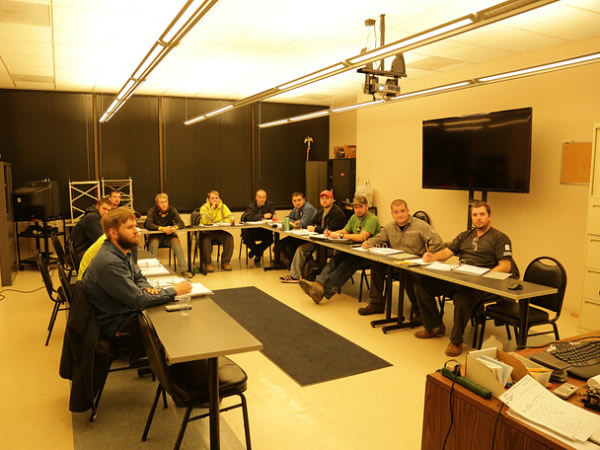
OSHA: Protecting Workers in the Elevator Industry and Beyond
When a member of the public steps into an elevator, they rarely think about the work that goes into ensuring the safety and reliability of the experience. As members of the trade, however, safety is at the core of everything we do. And yet, in the same way the riding public may be unaware of the hard work we carry out to ensure their safety, it’s easy to forget about the vital role played in guaranteeing our safety by the Occupational Safety and Health Administration (OSHA).
OSHA is the organization charged with making sure workers have the protections they need to get home safely at the end of the day. At NEIEP, we understand just how pivotal OSHA is to our trade and many others. Let’s take a look at how and why OSHA was established, and why its continued existence is paramount for worker safety across the nation.

What Is OSHA and Why Was it Created?
Before OSHA was established, the American workplace was a much more dangerous place. Construction sites lacked clear safety protocols, workers regularly handled hazardous materials without protective equipment, and injuries and fatalities were considered just part of the job. In the 1960s, workplace accidents were so frequent that roughly 14,000 workers died on the job annually. In 1970, OSHA was created after the Occupational Safety and Health Act came into effect. This made OSHA the federal agency responsible for enforcing workplace safety standards.
In the decades since then, OSHA has been instrumental in making workplaces across the nation safer. OSHA sets regulations, conducts inspections, and provides resources to ensure employers maintain safe working environments. In industries like ours, where workers are exposed to fall hazards, electrical risks, and heavy machinery, these regulations are nothing short of lifesaving measures.
The Impact of OSHA on the Elevator Industry
The elevator trade presents unique safety challenges. Workers contend with confined spaces, extreme heights, and powerful electrical systems daily. Without proper safety measures, the risks are amplified. Luckily, in the years since OSHA was established, the industry has seen substantial improvements in workplace safety.
For example, OSHA’s fall protection standards require Elevator Constructors to use harnesses and other personal protective equipment (PPE) when working at heights. Falls from elevator hoistways and platforms were a leading cause of injuries and fatalities in the past. By enforcing strict rules on fall protection and proper scaffolding, OSHA has significantly reduced the number of serious accidents.
Another way OSHA has helped prevent injuries is through its lockout/tagout (LOTO) procedures. Before these regulations, Elevator Constructors would be exposed to live electrical components and caught-in and between hazards. This change reduced common incidents such as shocks, burns, electrocution, and crushing injuries.
How OSHA Benefits Elevator Constructors and the Industry at Large
Beyond specific regulations, OSHA plays a broader role in shaping the culture of safety in the workplace. OSHA benefits all of us in the elevator industry. Here’s how:
Training and Education
OSHA requires employers to provide safety training to all workers who face hazards on the job, and these programs serve as the foundation of the education offered by NEIEP. By making safety priority number one, we ensure that professionals in the industry always follow best practices.
Worksite Inspections
OSHA inspectors work to help identify hazards before they lead to accidents serving as an extra layer of protection and reinforcing the importance of safety compliance.
Accountability for Employers
OSHA holds companies accountable for providing safe working conditions by setting and enforcing standards to ensure workplaces are free from serious recognized hazards. OSHA also administers the Whistleblower Protection program, ensuring an employer cannot retaliate by taking “adverse action” against workers who report injuries, safety concerns, or other protected activity.
Continued Innovation in Safety
As new technologies emerge, OSHA updates its standards to keep pace. The elevator industry is evolving, and OSHA’s role ensures that safety remains a top priority as these advancements unfold.
How NEIEP Supports OSHA’s Mission
Despite its undeniably positive impact on our industry and others, OSHA faces opposition from some who argue that regulations are burdensome or unnecessary. History has shown, however, that when workplace safety standards are relaxed, injuries and fatalities rise. Since OSHA’s establishment, workplace fatalities have dropped significantly.
In the elevator industry specifically, improved safety measures have saved countless lives, prevented injuries, and reduced long-term health complications for workers. This tells us that OSHA’s oversight isn’t just beneficial, it’s essential.
At NEIEP, our program incorporates OSHA’s standards into our curriculum, making sure that from day one, students understand the importance of hazard assessments, PPE use, fall protection, electrical safety, and more. We also encourage our members to stay up to date with OSHA’s evolving regulations, reinforcing the idea that safety is a lifelong commitment.
The Future of Workplace Safety
The fight for safer working conditions is never truly over. As our industry grows and technology changes, new hazards will emerge. OSHA’s continued role in enforcing safety regulations, coupled with NEIEP’s standout education and safety training, will ensure that Elevator Constructors can do their jobs with confidence and security.
Supporting OSHA isn’t just about preserving an agency, it’s about valuing human life and recognizing that no job is worth an unnecessary risk. That’s why, as an industry and as a workforce, we must stand behind OSHA and advocate for the continued enforcement of workplace safety laws. At the end of the day, no one should have to choose between making a living and staying alive.
